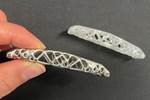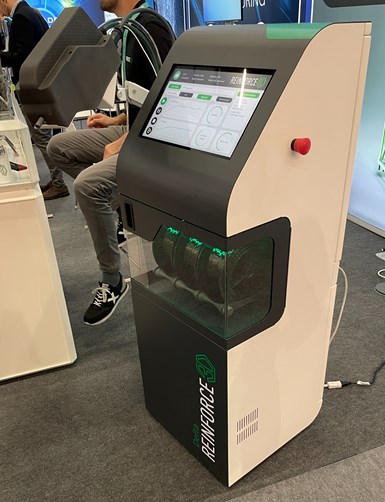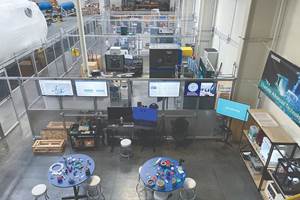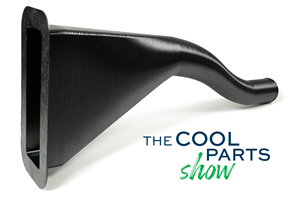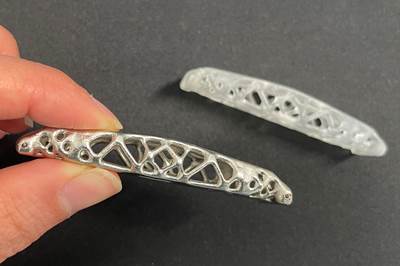In additive manufacturing, there can be an expectation that parts should require only minimal processing once they leave the printer — and ideally, should be ready to go as soon as they are removed from the build plate. But new postprocessing options can offer enhancements beyond what 3D printing alone can achieve.
Reinforce 3D is offering such an option: a technique for strengthening 3D printed parts after the fact. The Spain-based startup premiered its Delta system at Formnext 2023, along with its method of reinforcing through a combination of continuous fiber and resin fed through channels inside of parts that it calls Continuous Fiber Injection Process (CFIP).
How Continuous Fiber Injection Process (CFIP) Works
The Delta system from Reinforce 3D feeds continuous carbon fiber (seen on the spools) and standard composites industry resins into parts through the nozzle at the upper left of this image.
For 3D printed parts, the CFIP technique works like this: The part is designed just as it would normally be (including the use of strategies such as generative design and topology optimization), with the inclusion of channels for reinforcement that also have entry points on the surface of the part.
After printing and cleaning, these openings are connected to a nozzle on the Delta platform which then forces continuous fiber lubricated with resin through the channels. Carbon fiber formatted by Reinforce 3D is the reinforcing material currently offered, but other materials could be used as well; resins are off-the-shelf. When the channels are filled, the resin is cured (either at room temperature or in an oven, depending on the material) and the part is ready for use.
The dark circles on the bottom of this aluminum bracket component show where the CFIP reinforcement entered and exited the part.
Curing the resin is the slowest part of the process; the reinforcing step itself takes only minutes. The Delta machine requires manual placement of the nozzle today, but the company says that it could be paired with a teachable robot to automate the process for serial production in the future.
Benefits of CFIP
For polymer parts, CFIP offers greater strength than these materials could achieve alone, in some cases approaching the mechanical properties of aluminum. For metal parts, CFIP provides strength while reducing the overall weight of the part and its material costs.
“Titanium is not going away,” says Blanca Garro, Reinforce 3D CEO. “But today we are using titanium for many 3D printed parts because there are no other options.” Combining 3D printed titanium with this reinforcing strategy could mean that less of this expensive material might be needed to produce a given part.
The most promising application of all might be assemblies. The fiber and resin can be used to join parts made through the same printing process, as well as those produced in different materials and through other manufacturing methods. As long as components include through-channels of an appropriate size, CFIP can in theory be applied.
This brake pedal was primarily 3D printed in a clear photopolymer, with metal parts attached during the CFIP process.
Reinforce 3D showed various examples of this benefit at Formnext, including a brake pedal lever made up of photopolymer printed plastic and off-the-shelf metal clips, and a satellite bracket combining a laser powder bed fusion aluminum component and a Multi Jet Fusion nylon piece. The latter appeared in our 8 Cool Parts From Formnext 2023 episode of The Cool Parts Show — watch it here.
Other applications for the CFIP method include sporting goods, robot components, tooling and automotive parts. The company anticipates that the added part strength made possible with this method will increase the opportunities for 3D printing, by increasing the number of demanding applications where this process can be affordably applied.
“We want to make the market bigger,” Garro says, “by making the business case for AM both technically and economically viable.”
Transcript
What if you could make your 3D printed parts stronger after printing? That's what Reinforce 3D is working on.
I'm Stephanie Hendrixson here at Formnext 2023, standing in front of the Reinforce 3D booth. They are a Spain-based startup and they are working on what they call Continuous Fiber Injection Process (CFIP).
Here's how it works: You design, optimize, 3D print your part the same as you would anyway. You can use any technology, any material, as long as you leave channels inside for the reinforcement. Then you connect your part to this machine. This is their Delta platform. It has spools of continuous carbon fiber, it has standard composites industry resins. Those two materials are combined and then fed through this nozzle which then fills in and reinforces the part.
And so this can be used to make a polymer part stronger with strength approaching something like aluminum, so you can actually lightweight and produce parts that are lighter and less expensive. You can even use it to connect to parts that have been printed with the same technology or made in different ways, even combining different materials.
So this part, for example, combines 3D printed SLA polymer and metal components. The reinforcement runs straight through all of the parts joining them together.
Right now with the Delta platform this is a manual process to attach the part to the nozzle, but it could be automated. You could teach a robot how to do this, how to apply the reinforcement to parts in series for a more autonomous process.
Related Content
Next-Gen Horse Trailers to Be Built With Robotic 3D Printing
Double D Trailers is currently developing a prototype horse trailer that will be made with large-format additive manufacturing. The technology brings potential benefits for labor, weight and design features to this subset of recreational vehicles.
Read MoreAdvancing Additive Manufacturing With a CATCH and Release Approach
Solutions for energy efficiency, sustainability, part repair and more are developing at Siemens’ Charlotte Advanced Technology Collaboration Hub (CATCH) in North Carolina.
Read MoreAircraft Ducts 3D Printed in Composite Instead of Metal: The Cool Parts Show #68
Eaton’s new reinforced PEKK, tailored to aircraft applications, provides a cheaper and faster way to make ducts compared to formed aluminum.
Read MoreEvaluating the Printability and Mechanical Properties of LFAM Regrind
A study conducted by SABIC and Local Motors identified potential for the reuse of scrap reinforced polymer from large-format additive manufacturing. As this method increases in popularity, sustainable practices for recycling excess materials is a burgeoning concern.
Read MoreRead Next
Possibilities From Electroplating 3D Printed Plastic Parts
Adding layers of nickel or copper to 3D printed polymer can impart desired properties such as electrical conductivity, EMI shielding, abrasion resistance and improved strength — approaching and even exceeding 3D printed metal, according to RePliForm.
Read MoreTo Improve Performance of Compression Molded Composites, Add 3D Printed Preforms
9T Labs' Additive Fusion Technology enables the manufacture of composite structures with as much or as little reinforcement as is necessary, using 3D printed continuous fiber preforms to add strength just where needed.
Read MoreProfilometry-Based Indentation Plastometry (PIP) as an Alternative to Standard Tensile Testing
UK-based Plastometrex offers a benchtop testing device utilizing PIP to quickly and easily analyze the yield strength, tensile strength and uniform elongation of samples and even printed parts. The solution is particularly useful for additive manufacturing.
Read More

.jpg;width=70;height=70;mode=crop)
